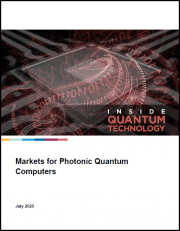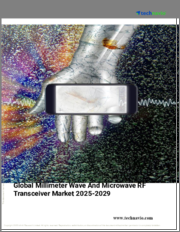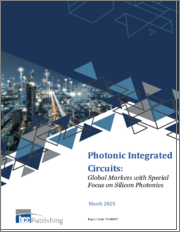
|
시장보고서
상품코드
1767025
포토닉 양자 컴퓨터 시장Markets for Photonic Quantum Computers |
||||||
포토닉 양자 컴퓨터는 (1)실온에서의 계산이 가능하고, (2)통신 업계용 기성품 광네트워크 컴포넌트를 이용하여 저비용으로 구축 가능하다는 신념에 힘입어 시행 가능한 양자 컴퓨팅 플랫폼으로서 급속히 부상하고 있습니다. 이 보고서의 주요 목적은 포토닉스를 주요 패브릭으로 사용하는 양자 컴퓨터의 상업적 가능성을 분석·정량화하고, 판매를 예측하는 것입니다. 2030년까지 세계의 포토닉스 양자 컴퓨터 시장 규모는 11억 달러에 달하며, 2035년에는 68억 달러 이상으로 성장할 것으로 예측됩니다. 공급측에서는 새로운 기업이 포토닉 컴퓨터 시장에 참여합니다. 수요측에서는 양자컴퓨터 전체의 수요가 급격히 증가하며, 이 높은 성장은 포토닉 QC에 영향을 미칠 것입ㅂ니다.
현재 풀 스택 포토닉 양자 컴퓨터를 상업화하고 있는 벤더는 이미 20사 정도 있으며, 그 중에서도 PsiQuantum은 지금까지 최대 자금을 유치했으며, Xanadu도 큰 주목을 받고 있습니다. Beijing Bose Quantum, Technology, Mitre Corporation, NTT, ORCA, Photonic, Quickly Quantum, PsiQuantum, Q.Ant, QC82, Quandela, Quanfluence, Quantum Computing, Inc, Quantum Source Labs, QuiXQuantum, Rotonium, Tundra Systems, Turing, Xanadu Quantum Technologies 등 모든 풀 스택 포토닉 컴퓨터 제조업체의 제품/시장 전략을 분석하고 있습니다.
신생 포토닉 양자 시스템 분야에 관련된 컴포넌트, PIC, 소프트웨어 공급업체를 소개하고, 포토닉 컴퓨터 시장의 10년 예측도 게재하고 있습니다. 예측은, "유틸리티 클래스", "HPC/기업", "기타"의 3 유형으로 구분하여 대수 기반과 금액 기반 양측에서 제공하고 있습니다. 또한 포토닉 양자 컴퓨터 애플리케이션에 관한 장도 마련하여 포토닉 컴퓨터가 특별히 선호되는 분야에 대해서도 언급하고 있습니다.
목차
제1장 포토닉 양자 컴퓨터 : 제품과 업계 배경
- 보고서의 배경
- 포토닉 양자 컴퓨터의 이점
- 포토닉 양자 컴퓨터의 과제
- 포토닉 양자 컴퓨터의 유형
- 포토닉 양자 컴퓨터용 칩과 칩셋
- 연구기관 및 대학
- 상업 공급업체
- 컴포넌트와 서브시스템
- 레이저와 광원
- 주파수 빗
- 광자 검출기
- 컨트롤 칩
- SDK
- 포토닉 양자 컴퓨터(QC) 새로운 아키텍처
- CV 아키텍처
- T센터 아키텍처
- 밸류 QC 브랜드 커뮤니티 : 포토닉 QC에 대한 적용성
- Quandela Cloud
- Xanadu
- 포토닉 양자 컴퓨터 산업 구조
- 러시아와 중국
- 새로운 챕터
제2장 포토닉 양자 컴퓨터와 관련 제품
- Bose Quantum Technology/QBoson(중국)
- 현재 제품
- 고객 기반과 시장
- Electronics and Telecommunications Research Institute(ETRI)(한국)
- InfamousPlatypus(미국)
- 고객 기반과 경쟁
- MITRE Corporation/CVE(미국)
- 양자 문샷
- 고객 기반
- NTT(일본)
- 현재의 조사
- ORCA Computing(영국)
- PT 시리즈 제품
- COTS의 사용
- ORCA 고객 : HPC에서의 사용
- Photonic(캐나다)
- 제품과 기술의 진화
- 고객 기반과 경쟁
- PsiQuantum(미국)
- 기술의 진화
- 고객 기반과 경쟁
- Q.Ant(독일)
- QC82(미국)
- 회사의 목표
- 상정되는 고객 기반
- Quandela
- 테크놀러지와 제조
- Quandela Cloud
- 고객 기반과 경쟁
- Quanfluence(인도)
- Quantum Computing, Inc.(미국)
- 현재 제품과 서비스
- 고객 기반과 경쟁
- Quantum Source Labs(이스라엘)
- 컴퓨터 전략
- 고객 기반
- QuiX Quantum(네덜란드)
- 현재 제품
- 고객
- Rotonium(이탈리아)
- 조사와 제품 개발의 방향성
- 제조업
- 잠재적 고객 기반
- Spooky Manufacturing(미국)
- TundraSystems Global LTD(영국)
- TuringQ(중국)
- 양자 컴퓨터 제공과 제조
- 고객 기반
- Xanadu Quantum Technologies(캐나다)
- 제품과 테크놀러지
- 제조업
- 고객과 파트너
- Xanadu Cloud 클라우드의 흥망
- 컴포넌트
- ID Quantique(스위스)
- M-Labs(중국)
- Menlo Systems(독일)
- Nanofiber Quantum Technologies(일본)
- Nexus Photonics(미국)
- Nicslab(미국)
- Sparrow Quantum(덴마크)
- Toptica Photonics(독일)
- Toshiba(일본)
- Vescent(미국)
- 서비스
- Iceberg Quantum(호주)
- 소프트웨어
- QC Design(독일)
- QMware(스위스)
- 플랫폼
- qBraid(미국)
- 연구기관과 대학
- Centre for Quantum Computation and Communication Technology(CQC2T)(호주)
- Griffith University(호주)
- Harvard University(미국)
- Institute for Photonic Quantum Systems(PhoQC)(독일)
- Israeli Quantum Computing Center(IQCC)(이스라엘)
- Nanjing University(중국)
- National Quantum Computing Center(NQCC)(영국)
- National Quantum Laboratory(NQL)(러시아)
- Niels Bohr Institute(NBI)(덴마크)
- Poznan Supercomputing and Networking Center((PSNC)
- Queensland University of Technology(QUT)(호주)
- RIKEN(일본)
- Russian Quantum Center(러시아)
- Sandia National Laboratory(미국)
- Simon Fraser University(캐나다)
- University of Arizona(미국)
- University of Bristol(영국)
- University of New Mexico(미국)
- University of Queensland(호주)
- University of Science & Technology of China(USTC)
- University of Southern Queensland(UniSQ)(호주)
- University of the Sunshine Coast(호주)
- University of Virginia(UVA)(미국)
- University of Washington(UW)(미국)
- University of Waterloo(캐나다)
제3장 포토닉 양자 컴퓨터의 표적 용도
- 연구 기기와 연구실
- 양자 화학과 재료 과학
- 금융과 은행
- 군, 첩보, 항공우주
- 자동차·운송
- 에너지 업계
- 포토닉 컴퓨터 : 특정 장소용 설계
- 포토닉 컴퓨터와 HPC : 양자 슈퍼컴퓨터
- 데이터센터 규모의 포토닉 양자 컴퓨터
- 랙 마운트형 포토닉 컴퓨터
- 광 양자 엣지 컴퓨팅
- 양자 + AI
제4장 포토닉 양자 컴퓨터의 10년 예측
- 조사 방법
- 출하 예측
- 초기 출하
- 향후 5년간의 성장
- 제품 유형별 출하
- 대체 시나리오
- 애널리스트 소개
Photonic Quantum Computers are quickly emerging as a viable quantum computing platform driven by the belief that they can (1) compute at room temperatures and (2) can be built at low cost using off-the-shelf optical networking components intended for the telecom industry. Our primary goal in this report is to analyze and quantify the commercial potential of quantum computers using photonics for their main fabric and to forecast their sales. We show how by 2030, worldwide revenues from photonic quantum computers will have reached US$1.1 billions shipped but this number will grow to more than US$6.8 billions by 2035. On the supply side new firms will be entering the photonic computer market. On the demand side, the demand for quantum computers as a whole will increase dramatically, and this high growth will impact photonic QCs.
There are already around 20 vendors commercializing full stack photonic quantum at the present time with PsiQuantum having attracted the largest funding to date and Xanadu attracting considerable attention too. This report, analyzes the product/market strategies of all the manufacturers of full-stack photonic computers including Beijing Bose Quantum, Technology, Mitre Corporation, NTT, ORCA, Photonic, Quickly Quantum, PsiQuantum, Q.Ant,QC82, Quandela, Quanfluence, Quantum Computing, Inc., Quantum Source Labs, QuiXQuantum, Rotonium, Tundra Systems, Turing and Xanadu Quantum Technologies.
In this report we also profile the relevant component, PIC and software suppliers to the budding photonic quantum systems sector as well as including ten-year forecasts of photonic computer markets. The forecasts are broken out by three types of machines "Utility-Class," "HPC/enterprise" machines and "Other" forecasts are provided in both volume and value terms. We also include a Chapter on applications for photonic quantum computers, noting where photonic where photonic machines are especially favored.
Table of Contents
Chapter One: Photonic Quantum Computers: Products and Industry Background
- 1.1. Background to Report
- 1.2. Advantages of Photonic Quantum Computers
- 1.3. Challenges of Photonic Quantum Computers
- 1.4. Types of Photonic Quantum Computers
- 1.5. Chips and Chipsets for Photonic Quantum Computers
- 1.5.1. Research Institutes and Universities
- 1.5.2. Commercial Suppliers
- 1.6. Components and Subsystems
- 1.6.1. Lasers and Light Sources
- 1.6.2. Frequency Combs
- 1.6.3. Photon Detectors
- 1.6.4. Control Chips
- 1.6.5. SDKs
- 1.7. Novel Architectures for Photonic QCs
- 1.7.1. CV Architectures
- 1.7.2. T Centre architecture
- 1.8. The Value QC Brand Communities: Applicability to Photonic QCs
- 1.8.1. Quandela Cloud
- 1.8.2. Xanadu
- 1.9. Photonic Quantum Computer Industry Structure
- 1.9.1. Russia and China
- 1.10. The Next Chapter
Chapter Two: Photonic Quantum Computers and Related Products
- 2.1. Bose Quantum Technology/QBoson (China)
- 2.1.1. Current Products
- 2.1.2. Customer Base and Markets
- 2.2. Electronics and Telecommunications Research Institute (ETRI) (Korea)
- 2.3. InfamousPlatypus (United States)
- 2.3.1. Customer Base and Competition
- 2.4. MITRE Corporation/CVE (United States)
- 2.4.1. Quantum Moonshot
- 2.4.2. Customer Base
- 2.5. NTT (Japan)
- 2.5.1. Current Research
- 2.6. ORCA Computing (United Kingdom)
- 2.6.1. PT Series Products
- 2.6.2. Use of COTS
- 2.6.3. ORCA Customers: Use with HPC
- 2.7. Photonic (Canada)
- 2.7.1. Product and Technology Evolution
- 2.7.2. Customer Base and Competition
- 2.8. PsiQuantum (United States)
- 2.8.1. Technical Evolution
- 2.8.2. Customer Base and Competition
- 2.9. Q.Ant (Germany)
- 2.10. QC82 (United States)
- 2.10.1. Goals of Company
- 2.10.2. Expected Customer Base
- 2.11. Quandela
- 2.11.1. Technology and Manufacturing
- 2.11.2. Quandela Cloud
- 2.11.3. Customer Base and Competition
- 2.12. Quanfluence (India)
- 2.13. Quantum Computing, Inc. United States)
- 2.13.1. Current Products and Services
- 2.13.2. Customer Base and Competition
- 2.14. Quantum Source Labs (Israel)
- 2.14.1. Computer Strategy
- 2.14.2. Customer Base
- 2.15. QuiX Quantum (The Netherlands)
- 2.15.1. Current Products
- 2.15.2. Customers
- 2.16. Rotonium (Italy)
- 2.16.1. Direction of Research and Product Development
- 2.16.2. Manufacturing
- 2.16.3. Possible Customer Base
- 2.17. Spooky Manufacturing (United States)
- 2.18. TundraSystems Global LTD (United Kingdom)
- 2.19. TuringQ (China)
- 2.19.1. Quantum Computer Offerings and Manufacturing
- 2.19.2. Customer Base
- 2.20. Xanadu Quantum Technologies (Canada)
- 2.20.1. Products and Technology
- 2.20.2. Manufacturing
- 2.20.3. Customers and Partners
- 2.20.4. The Rise and Fall of Xanadu Cloud
- 2.21. Components
- 2.21.1. ID Quantique (Switzerland)
- 2.21.2. M-Labs (China)
- 2.21.3. Menlo Systems (Germany)
- 2.21.4. Nanofiber Quantum Technologies (Japan)
- 2.21.5. Nexus Photonics (United States)
- 2.21.6. Nicslab (United States)
- 2.21.7. Sparrow Quantum (Denmark)
- 2.21.8. Toptica Photonics (Germany)
- 2.21.9. Toshiba (Japan)
- 2.21.10. Vescent (United States)
- 2.22. Services
- 2.22.1. Iceberg Quantum (Australia)
- 2.23. Software
- 2.23.1. QC Design (Germany)
- 2.23.2. QMware (Switzerland)
- 2.24. Platforms
- 2.24.1. qBraid (United States)
- 2.25. Research and Universities
- 2.25.1. Centre for Quantum Computation and Communication Technology (CQC2T) (Australia)
- 2.25.2. Griffith University (Australia)
- 2.25.3. Harvard University ( United States)
- 2.25.4. Institute for Photonic Quantum Systems (PhoQC) (Germany)
- 2.25.5. Israeli Quantum Computing Center (IQCC) (Israel)
- 2.25.6. Nanjing University (China)
- 2.25.7. National Quantum Computing Center (NQCC) (United Kingdom)
- 2.25.8. National Quantum Laboratory (NQL) (Russia)
- 2.25.9. Niels Bohr Institute (NBI) (Denmark)
- 2.25.10. Poznan Supercomputing and Networking Center (PSNC)
- 2.25.11. Queensland University of Technology (QUT) (Australia)
- 2.25.12. RIKEN (Japan)
- 2.25.13. Russian Quantum Center (Russia)
- 2.25.14. Sandia National Laboratory (United States)
- 2.25.15. Simon Fraser University (Canada)
- 2.25.16. University of Arizona (United States)
- 2.25.17. University of Bristol (United Kingdom)
- 2.25.18. University of New Mexico (United States)
- 2.25.19. University of Queensland (Australia)
- 2.25.20. University of Science & Technology of China (USTC)
- 2.25.21. University of Southern Queensland (UniSQ) (Australia)
- 2.25.22. University of the Sunshine Coast (Australia)
- 2.25.23. University of Virginia (UVA) (United States)
- 2.25.24. University of Washington (UW) (United States)
- 2.25.25. University of Waterloo (Canada)
Chapter Three: Target Applications for Photonic Quantum Computers
- 3.1. Research Machines and Laboratories
- 3.2. Quantum Chemistry and Materials Science
- 3.3. Finance and Banking
- 3.4. Military, Intelligence and Aerospace
- 3.5. Automotive and Transportation
- 3.6. The Energy Industry
- 3.7. Photonic Computers: Design for Specific Locations
- 3.7.1. Photonic Computers and HPC: The Quantum Supercomputer
- 3.7.2. Data Center Scale Photonic Quantum Computers
- 3.7.3. Rack-Mounted Photonic Computers
- 3.7.4. Photonic Quantum Edge Computing
- 3.8. Quantum + AI
Chapter Four: Ten-year Forecasts of Photonic Quantum Computers
- 4.1. Methodology
- 4.2. Shipment Forecast
- 4.2.1. Initial Shipments
- 4.2.2. Growth Over the Next Five Years
- 4.3. Shipments by Product Type
- 4.4. Alternative Scenarios
- About the Analyst
List of Exhibits
- Exhibit 4-1: Shipments of QCs vs. Photonic QCs
- Exhibit 4-2: Worldwide Shipments of Photonic QCs by Type



















